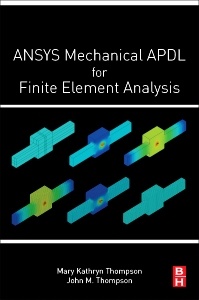ANSYS Mechanical APDL for Finite Element Analysis
Auteurs : Thompson Mary Kathryn, Thompson John Martin

ANSYS Mechanical APDL for Finite Element Analysis provides a hands-on introduction to engineering analysis using one of the most powerful commercial general purposes finite element programs on the market. Students will find a practical and integrated approach that combines finite element theory with best practices for developing, verifying, validating and interpreting the results of finite element models, while engineering professionals will appreciate the deep insight presented on the program?s structure and behavior. Additional topics covered include an introduction to commands, input files, batch processing, and other advanced features in ANSYS.
The book is written in a lecture/lab style, and each topic is supported by examples, exercises and suggestions for additional readings in the program documentation. Exercises gradually increase in difficulty and complexity, helping readers quickly gain confidence to independently use the program. This provides a solid foundation on which to build, preparing readers to become power users who can take advantage of everything the program has to offer.
John is a Mechanical Engineer with almost 50 years of experience using the finite element method for engineering analysis. From 1967 to 1971, he worked with special purpose finite element programs at the Westinghouse Electric Corporation. He switched to general purpose finite element programs with the initial release of ANSYS in 1971. John served as a consultant to the ANSYS Headquarters Technical Support Group for 20 years where he specialized in nonlinear material models, APDL, User Programmable Features, specialty applications, and other non-standard uses and customizations of the program. He has used ANSYS as a consulting engineer to support Fortune 500 companies and has taught ANSYS and finite element analysis at the Massachusetts Institute of Technology (MIT) and the Korea Advanced Institute of Technology (KAIST). John is currently a Professor of Industrial and Engineering Technology and a registered Professional Engineer in the Commonwealth of Pennsylvania. He earned his B.S.M.E., M.S.M.E., and Ph.D. in Mechanical Engineering from the University of Pittsburgh.
- Includes the latest information on ANSYS Mechanical APDL for Finite Element Analysis
- Aims to prepare readers to create industry standard models with ANSYS in five days or less
- Provides self-study exercises that gradually build in complexity, helping the reader transition from novice to mastery of ANSYS
- References the ANSYS documentation throughout, focusing on developing overall competence with the software before tackling any specific application
- Prepares the reader to work with commands, input files and other advanced techniques
Date de parution : 08-2017
Ouvrage de 466 p.
21.4x27.6 cm
Thème d’ANSYS Mechanical APDL for Finite Element Analysis :
Mots-clés :
ANSYS Inc; ANSYS Mechanical APDL; ANSYS native solid modeler; Analysis procedure; Animation; Anisotropy; Array parameter; Assemblies; BEAM189; Backward compatibility; Batch file; Batch files; Batch mode; Beam tool; Boolean operations; Bottom-up solid modeling; Boundary conditions; Cantilever beam; Color contours; Command dictionary; Commands; Commenting; Components; Concatenation; Concurrent Method; Concurrent method; Conduction; Constraints; Convection; Convergence tracking; Coordinate systems; Database; Database log file; Debugging; Degenerate shapes; Degrees of freedom; Direct Method; Direct generation; Direct method; Discontinuities; Documentation; Elastic-plastic material model; Element attributes; Element edge length; Element families; Element output; Element shape display; Element shape function; Element shape testing; Element table; Element types; End of File (/EOF) command; Energy error; Energy error estimation; Engineering analysis; Entity selection; Extrusion; File structure; Finite element analysis; Finite element method; Forward compatibility; Free meshing; Full Graphics; Full graphics; Graphical User Interface (GUI); Graphical solution tracking; Heat generation; Help; History of ANSYS; Importing geometry; Initial conditions; Input file; Input files; Key option; Key options; LINK180; Linear elastic; Linear material properties; Listing results; Load case combinations; Load steps; Loads; Local coordinate system; Log file; Mapped meshing; Material curves; Material models; Mesh attributes; Mesh convergence; Mesh quality; Mesh refinement; Nonlinear material properties; Notched plate; One-dimensional analysis; Output file; PLANE182; PLANE183; PLANE55; Picker block; Plasticity analysis



